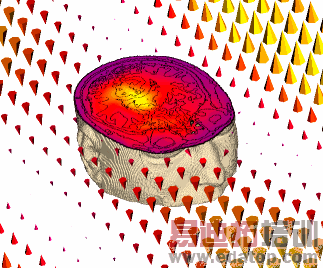- 易迪拓培训,专注于微波、射频、天线设计工程师的培养
CST2013: SAR Calculation Overview
The SAR calculation can be carried out as a post-processing step after the simulation. You must define a power loss density monitor to calculate the SAR values and fields. It is recommended to use the FPBA mesh type for SAR simulations.
Definition The Specific Absorption Rate (SAR) is defined as the time derivative of the incremental energy (dW ) absorbed by (dissipated in) an incremental mass (dm) contained in a volume element (dV) of a given mass density ( r ).
The SAR value is expressed in units of watts per kilogram (W/kg). The Power Loss Density (PLD) value is expressed in units of watts per cubic meter (W/m^3). |
SAR calculation
CST MICROWAVE STUDIO offers whole-body-averaged and local SAR values:
Whole-body-averaged SAR: The value is obtained by dividing the total power absorbed in the human body by the full body weight. It is also possible to define a sub volume by picks or by numbers.
Local SAR: SAR is given as a numerical value per volume element and becomes a space distribution function. For this function, the mass mean value in arbitrary tissue volume is called local SAR. Typical local SAR values are averaged in tissue masses of around 10g specified by the Telecommunication Technology Council Agenda No. 89 and CENELEC 1995, whereas the value of 1g is adopted by ANSI/IEEE C95.1-1992 of the United States. A cuboid averaging volume is used.
SAR result file
The SAR results file can be accessed in the SAR calculation dialog and by clicking Edit->Info while the SAR field result is selected in the navigation tree. It contains the following:
Power scaling: Indicates if the whole SAR result is rescaled to a user defined power.
Stimulated Power: Input power of the SAR calculation.
Accepted Power: Input power of the SAR calculation without reflection losses.
Sys.Stimulated Power: Stimulated power of the circuit excitation (if used).
Sys.Accepted Power: Accepted power of the circuit excitation (if used).
AR filter results: Indicates the availability of AR filter balance results.
Powerloss density monitor used: Name and frequency of the power loss density monitor used to calculate this SAR results.
Average cell mass: The average mass of all grid cells which contain material with mass density (rho) greater zero.
Averaging method: The method used to calculate spatial averaged SAR if not Point SAR has been calculated.
Averaging mass / Averaging volume: The mass of the averaging cube used for spatial averaging. If "Constant volume" has been choosen as averaging method, the volume of the cube is given. If Point SAR has been calculated, zero is output.
Entire Volume / Selected Volume: The following values apply to the entire calculation domain or the selected subvolume respectively.
Min / Max / Volume: The spatial dimensions and the volume of the calculation domain or subvolume respectively.
Absorbed power: The total power absorbed in biological tissue and other lossy normal material. Please note that lossy metal is not included.
Tissue volume / Tissue mass: The volume and mass of the biological tissue contained in the entire calculation domain or subvolume respectively.
Tissue power: The power absorbed in biological tissue (all material with mass density greater zero).
Average power: The average power absorbed in biological tissue (all material with mass density greater zero).
Total SAR: The tissue power divided by the tissue mass.
Max. point SAR: The maximum point SAR of all grid cells. For each grid cell, its point SAR is calculated by its absorbed power divided by its mass.
Maximum SAR: The maximum of the spatially averaged SAR for the given averaging mass. For point SAR calculations, the averaging mass is denoted as zero.
Maximum at: The spatial position of the above maximum.
Avg.vol.min / Avg.vol.max: Gives the dimensions and position of the averaging cube used for the above maximum. Note that if statistics for both the entire and the selected volume are output, the averaging cube is only output for the selected volume.
Largest valid cube: Edge length of the largest valid averaging volume.
Smallest valid cube: Edge length of the smallest valid averaging volume.
Avg.Vol.Accuracy: Volume accuracy of the averaging cubes used for in SAR calculation.
Calculation time: Time used for the SAR calculation.
Human model and tissue properties
Use the Voxel Data Import for very realistic SAR calculations or assign the appropriate material properties to your arbitrary human models using the material dialog.
CST微波工作室培训课程套装,专家讲解,视频教学,帮助您快速学习掌握CST设计应用
上一篇:CST2013: Thermal Transient Solver Overview
下一篇:CST2013: Post Processing Overview
 最全面、最专业的CST微波工作室视频培训课程,可以帮助您从零开始,全面系统学习CST的设计应用【More..】
最全面、最专业的CST微波工作室视频培训课程,可以帮助您从零开始,全面系统学习CST的设计应用【More..】
频道总排行
- CST2013: Mesh Problem Handling
- CST2013: Field Source Overview
- CST2013: Discrete Port Overview
- CST2013: Sources and Boundary C
- CST2013: Multipin Port Overview
- CST2013: Farfield Overview
- CST2013: Waveguide Port
- CST2013: Frequency Domain Solver
- CST2013: Import ODB++ Files
- CST2013: Settings for Floquet B


